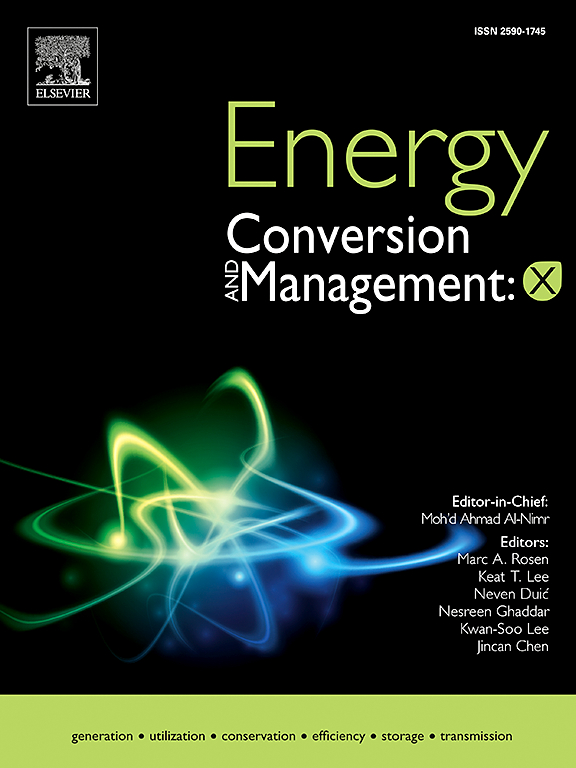Thermal and electromagnetic analysis of a 200 kVA transformer with heat pipe cooling
IF 7.6
Q1 ENERGY & FUELS
引用次数: 0
Abstract
Integrating copper wicked heat pipes (CWHPs) is a proven method to improve oil immersed power transformer (OIP/transformer) heat dissipation. However, determining the most effective placement and number of the heat pipes, and addressing electrical and magnetic constraints associated with the heat pipes integration remains a challenge. This study combines numerical modeling of a 200 kVA OIP/transformer with experimental analysis of a CWHP’s performance to identify the most suitable number and arrangement of CWHPs. Results show that the replacement of cooling fins with 58 CWHPs – even before optimizing their placements − decreases hot-spot temperature (HS/temperature) by 9.8 °C. Besides thermal performance, numerical modeling was conducted to assess the potential electrical and magnetic impacts of the CWHPs, demonstrating almost no negative effects on the OIP/transformer in this sense. However, small eddy currents induced in CWHPs by magnetic field fluctuations generate a very tiny extra heat loss of 0.799 W, an insignificant figure compared to the total 2986 W dissipated heat by active components. Generally, using 28 CWHPs located distant from active components provides optimum temperature reduction in HS/temperature by 14.3%. This will significantly enhance the insulation life of windings as well as the reliability of the OIP/transformer. The results of this article demonstrate the practicability and effectiveness of utilizing CWHPs as a thermal management system for OIP/transformers.
200kva热管冷却变压器的热学和电磁分析
集成铜芯热管是改善油浸式电力变压器(OIP/变压器)散热的一种行之有效的方法。然而,确定热管的最有效位置和数量,以及解决与热管集成相关的电和磁限制仍然是一个挑战。本研究将200kva OIP/变压器的数值模拟与CWHP性能的实验分析相结合,以确定最合适的CWHP数量和配置。结果表明,更换58个cwhp冷却鳍-甚至在优化其位置之前-热点温度(HS/temperature)降低了9.8°C。除热性能外,还进行了数值模拟以评估cwhp的潜在电和磁影响,结果表明在这方面对OIP/变压器几乎没有负面影响。然而,由磁场波动引起的小涡流在cwhp中产生的额外热损失非常小,为0.799 W,与有源元件的总散热量2986 W相比,这个数字微不足道。一般来说,使用28个远离活性组分的cwhp可以使HS/temperature降低14.3%。这将显著提高绕组的绝缘寿命以及OIP/变压器的可靠性。本文的结果证明了利用cwhp作为OIP/变压器热管理系统的实用性和有效性。
本文章由计算机程序翻译,如有差异,请以英文原文为准。
求助全文
约1分钟内获得全文
求助全文
来源期刊

Energy Conversion and Management-X
Multiple-
CiteScore
8.80
自引率
3.20%
发文量
180
审稿时长
58 days
期刊介绍:
Energy Conversion and Management: X is the open access extension of the reputable journal Energy Conversion and Management, serving as a platform for interdisciplinary research on a wide array of critical energy subjects. The journal is dedicated to publishing original contributions and in-depth technical review articles that present groundbreaking research on topics spanning energy generation, utilization, conversion, storage, transmission, conservation, management, and sustainability.
The scope of Energy Conversion and Management: X encompasses various forms of energy, including mechanical, thermal, nuclear, chemical, electromagnetic, magnetic, and electric energy. It addresses all known energy resources, highlighting both conventional sources like fossil fuels and nuclear power, as well as renewable resources such as solar, biomass, hydro, wind, geothermal, and ocean energy.
 求助内容:
求助内容: 应助结果提醒方式:
应助结果提醒方式:


